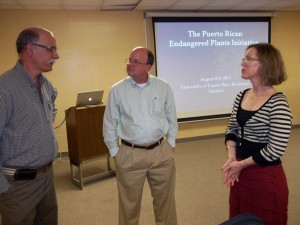The Puerto Rican Endangered Plants Initiative
Posted in Science on August 11 2011, by Jim Miller
| Jim Miller is Dean and Vice President for Science. |

The greatest challenge to protecting the world’s plant diversity is that while perhaps as many as 100,000 species of plants face some risk of extinction in the next few decades, in most parts of the world, we simply don’t know which species are the most threatened. Little progress has been made toward identifying the list of globally threatened plant species (which is target 2 of the United Nations Global Strategy for Plant Conservation), so NYBG scientists have developed a streamlined method to survey plant species one at a time, to determine which are “At Risk.”
This week, August 8 and 9, a consortium of 19 scientists met at the University of Puerto Rico’s Botanical Garden to review the situation for the 2,032 species of plants that are native to Puerto Rico, 461 of which have been determined to be “At Risk.” Botanists from The New York Botanical Garden conducted the workshop in partnership with colleagues from the Smithsonian Institution; the University of Puerto Rico, Río Piedras; the University of Puerto Rico, Mayagüez; the University’s Botanical Garden; Parque Doña Inés of the Fundación Luis Muñoz Marín; the International Institute of Tropical Forestry; Puerto Rico’s Department of Natural Resources; and the Fideicomiso de Conservación.
The rapid review of Puerto Rico’s plant species demonstrates that 461 of them, or 23%, are at possible risk of extinction in the near future. This figure is consistent with analyses from other parts of the world, where it is frequent that about one quarter of species are threatened. Some of these threatened plant species are so rare that they have not been seen for decades and are possibly extinct, others are known from countable numbers of individuals, some less than 25, and thankfully the situation for others is not as dire, though still serious. Having this list will help guide future conservation efforts to the species that most desperately need our attention to ensure their future survival. Some of the participants from the Puerto Rican institutions plan to propagate the most rare species as a prelude to efforts to re-establish viable populations in the wild. The NYBG is extending these efforts and is aiming to complete a review of the entire West Indies in the next year.
